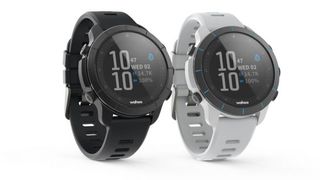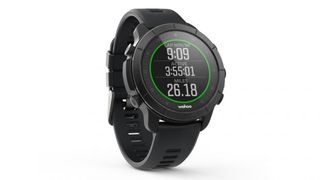You can trust Coach
Keen cyclists will already be well aware of Wahoo, which makes a range of excellent turbo trainers, one of our favourite exercise bikes (the KICKR Bike) and bike computers. Fitness enthusiasts of all types may well have come across the Wahoo TICKR chest strap heart rate monitor.
If you’ve used any of its gear, the odds are you’re a fan. I’ve been impressed by every Wahoo device I’ve tried, and the brand is well established as a Garmin rival in bike computers, while having a claim to the premium turbo trainer crown.
So there’s good reason to be excited about Wahoo’s first GPS multisports watch. While Coros has done great work in establishing itself as a rival to the traditionally dominant forces of Garmin, Polar and Suunto, this is still an area where fresh blood is welcome.
The Wahoo ELEMNT RIVAL watch is targeted at triathletes and costs £349.99, which puts it at the top end of the mid-range watch bracket. It’s cheaper than Garmin’s triathlon watches (aside from the older Forerunner 735XT), but more expensive than the Polar Vantage M, Coros Apex and the Coros Pace 2, the latter a very capable triathlon watch that costs just £180.
All the key hardware is in place on the RIVAL. It has a heart rate monitor, GPS plus Galileo for distance tracking, and a barometric altimeter for accurate elevation tracking. The watch is also able to connect to external sensors via both Bluetooth and ANT+, and it’s waterproof to 50m, with the ability to track both indoor and open-water swimming.

Battery life is listed at a solid 24 hours of GPS, or two weeks in watch mode. After a 1hr 50min run it dropped by 5 percentage points, which bodes well for that GPS battery life. So far I have found the watch drops at least 10 percentage points a day even if I only use it for a short run, so I’d roughly expect seven to 10 days of use overall.
The RIVAL’s design is similar to that of the Garmin Fenix, with a chunky build and shiny ceramic bezel, but the watch is much lighter at 53g – the Fenix 6 Pro is 83g for the steel version. The screen is a 240x240 transflective display that is clear to read even in bright sun. You can get an all-black watch or one with a white case and band underneath the bezel, and the quick-release 22mm band can be swapped out.

You can set up each sports mode to display your preferred stats, with a unique zoom feature that makes reading them easier. You can rank up to six stats on the workout page for a sport, then click a combination of buttons to change how many of those stats are displayed, so you can keep tabs on all six for important workouts when you want all the data possible, or easily switch to essentials like time and distance or even just heart rate when out for a easy run.

The RIVAL has template modes for a vast range of sports and several preset multisport modes you can use, including triathlon, duathlon and a run-bike brick session. One of the device’s most exciting features is touchless transitions, which means the watch recognises a switch in disciplines automatically. Plus, if you’re using a Wahoo bike computer for a triathlon it will link to the RIVAL and start recording your cycling stint while showing the stats on your swim and the time spent in transition.
If you’re not happy to rely on the automatic feature, you can manually log a transition. As well as the preset multisport modes you can switch to any other workout mode during a training session by holding the top right button, and your entire session will be synced as one to the partner Wahoo app.
So far I’ve only used the RIVAL for a 24km run. The distance tracking was good, and better than the Polar Vantage V2 on my other wrist which logged one rogue kilometre at far too fast a pace. However, the heart rate tracking was less impressive, frequently showing my rate as somewhere around 80-90bpm when it was actually between 120-135bpm. Hopefully this was a one-off problem, but if not, connecting the watch to a chest strap monitor will sort the problem.
I particularly liked the lap screen on the watch which displays all your splits in order. It’s something I’ve noticed on Suunto watches, but it’s missing from Garmin and Polar devices.
The tracking seems solid and in line with other devices, but at launch the RIVAL is lagging behind on other fronts. There’s no way to programme a structured workout and have the watch guide you through it. You’ll need to commit it to memory and press the lap button to mark each effort. Custom workouts should arrive in a post-launch update, but the timescale is yet to be confirmed.
See related
There are also no training insights to speak of – whether that’s how an individual training session has improved your fitness or if your overall training load is proving effective. It also lacks VO2 max estimates and advised recovery times. The watch is really just a tool to record your sessions, whereas Garmin and Polar offer increasingly impressive insights into your workouts and recovery that can help shape your training, and Coros at least offers some insights like VO2 max and overall training load effectiveness.
That is a problem at the RIVAL’s price. There are much cheaper Coros watches like the Pace 2 that offer equally good triathlon tracking plus structured workouts and basic training insights, though lacking more glossy features like touchless transitions.
At £350 you’re also within spitting distance of high-end triathlon watches like the Polar Vantage V2 and Garmin Forerunner 745. Both have an RRP of £450, but that price is already dropping to nearer £420 on some sites even though they’re fairly new. The V2 and 745 are light years ahead of the RIVAL for training insights and can offer training plans and structured workouts you follow on the wrist.
The RIVAL will gain more features in time through updates, and of course it’s a challenge to match the performance of companies that have been making watches for yonks. For now, the RIVAL is a solid sports tracker with a few novel features that should prove genuinely useful, especially if you already own other Wahoo products, but until more work is done to deliver key features like structured workouts, there are better options. Given Wahoo’s record I have faith those features will arrive, but holding off on the RIVAL is probably the smartest course of action for now.
Buy from Wahoo | £349.99

Nick Harris-Fry is a journalist who has been covering health and fitness since 2015. Nick is an avid runner, covering 70-110km a week, which gives him ample opportunity to test a wide range of running shoes and running gear. He is also the chief tester for fitness trackers and running watches, treadmills and exercise bikes, and workout headphones.

